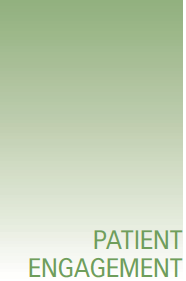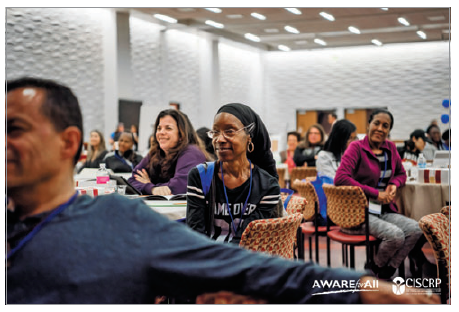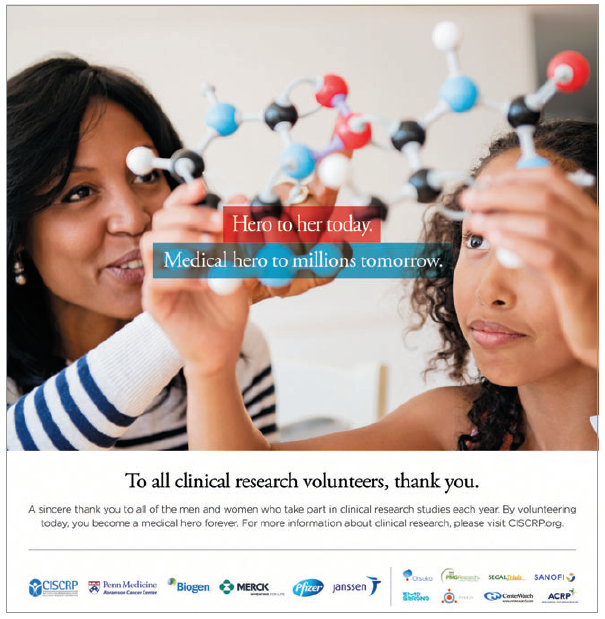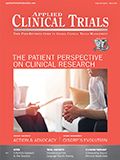New Models to Raise Public and Patient Awareness
Applied Clinical Trials
Tracking the evolution and effectiveness of CISCRP’s clinical research awareness and literacy campaigns.

Mass media coverage and popular cultural depictions of clinical research during the past decade have continued to grow. For the vast majority of the public, these channels are the dominant educational medium, becoming even more so with the rapid influx of programming and content that can be easily accessed and streamed over the internet and shared on social media. Most of this exposure-unfortunately-has been negative and/or unbalanced, focusing largely on risks, human error, and questionable motives.
During that same timeframe, new and expanded programs and initiatives designed to raise public awareness and improve clinical research literacy-particularly among minority and underserved communities-have been implemented. This article looks at the current environment for public and patient awareness and education and discusses changes that the Center for Information and Study on Clinical Research (CISCRP) and others are making to be more effective. These approaches have refined the focus of educational content and have better leveraged the reach and frequency of these outreach and communication channels. CISCRP’s novel programs are having an impact, and they are evolving and expanding to counteract the effects of wide-spread negative and unbalanced exposure.
A powerful communication channel
Broad reach, high frequency, and the integration of communication formats have reinforced and expanded the impact of news, entertainment, and social networks, but coverage is typically superficial, uninformed, and sensationalized. News media, for example, has no shortage of clinical research-related topics to write about, but news bureaus operate with leaner editorial staff today and rely increasingly on freelancers. And most journalists have little to no prior knowledge about clinical research and must hastily gather information and interview quotes while facing tight deadlines and editorial demands for headline-grabbing coverage. As a result, although some articles profile patients and families that have found hope in clinical trials and investigational treatments, the majority provide a negative and often sensationalistic focus on mistakes made by clinical research professionals, concealment, fraud, and corruption.
Given their expansive scope, the full reach of these channels is difficult to gauge. To assess frequency and positioning, CISCRP reviewed a convenience sample of content that appeared in newspapers and in film to assess how clinical research is depicted over time. We compiled and evaluated articles focusing specifically on patient experiences in clinical trials that appeared in three major national newspapers-USA Today, The New York Times, and The Wall Street Journal-between 2016 and 2018. The results of this assessment were compared with a similar approach conducted 15 years ago at CISCRP’s inception. We did not count the educational supplements that CISCRP has been recently producing and distributing through USA Today.
We observed a 27% increase in the number of articles that appeared in these major newspapers-33 that appeared in the 2001–2003 timeframe and 42 in the 2016–2018 period. We found that the proportion of articles that offered unbalanced, negative coverage had not changed during the 15-year time horizon. In the earlier period, 59% of the articles were negative; 60% of the articles were negative in the more recent period.
Trends in fictional film and television-two popular culture mediums with extensive reach-are even more alarming. There were very few films and TV movies focusing specifically on patients in clinical research in the 2003 timeframe. The Constant Gardner, starring Ralph Fiennes and Rachel Weiss, was released in 2005, and it focused on a healthcare activist murdered before she was able to expose a large pharmaceutical company that had been exploiting a vulnerable population of study volunteers. In 2018, we identified 10 major fictional stories in film and TV including Side Effects with Rooney Mara, Channing Tatum, and Jude Law; Dead Pool with Ryan Reynolds; and Maniac with Emma Stone and Jonah Hill. Each of these films depicts experimental treatments and procedures for severe and chronic medical conditions that have run amok. In 2017, Oprah Winfrey starred in a movie for HBO based on the best-selling book The Immortal Life of Henrietta Lacks. The film told the true story of HeLa cells, one of the most commonly used cell lines in scientific research, gathered without consent or remuneration to the patient and her family.
Although it is not their primary objective, the star power and story lines in these movies arguably reach and influence the largest audiences. All but one of these fictional movies provided any information that might help educate and inform patients with diverse medical conditions about clinical research and the participation process.
There is a silver lining. Most coverage in the mass media and in popular culture-including film and literature-is removed from and lacks personal relevance to a large percentage of its audience. The themes and messages are not tailored or targeted. They are unable to address the highly personalized nature of each person’s health, medical journey, and learning style enhanced by interactions with trusted advisors in individualized locations and communities.
Coverage in the news and in entertainment media is not coordinated and integrated into the many systems and stakeholders that facilitate patient engagement. Numerous studies in the literature demonstrate that clinical research participation is a team-based undertaking: patients rely on their personal healthcare providers and trusted family, friends, and professionals to make decisions and follow-through with their participation in clinical research.
CISCRP’s awareness-building and education strategy has been evolving to take advantage of these weaknesses.
Expanded and new public and patient awareness and education models
AWARE for All was CISCRP’s first public and patient awareness and education campaign, launched in 2003. At that time, we announced the new program in Applied Clinical Trials. It is a live event, produced in major metropolitan areas in the U.S. and to a lesser extent in Europe, that requires six to eight months of planning and awareness-building to engage patients, the public, local health and clinical research professionals, minority community centers, lay leaders, and community-based disease and patient advocacy groups. AWARE’s success depends greatly on the active participation and support of local stakeholders and the accessibility of the event to public transportation.
Since its introduction, AWARE’s format and outreach strategy have adapted to better accommodate local needs and attract diverse communities. From the outset, CISCRP has developed educational material with input from patients and the lay community to ensure that it is culturally sensitive at the grassroots level. Between 2003–2012, CISCRP hosted three events annually, typically on a Saturday as a full-day program with nine or 10 breakout workshops. Three to five free health screenings were provided at these AWARE programs. Depending on local community involvement location, each program received between 150 and 250 attendees. While audience members enjoyed extensive educational programming with an opportunity to select workshops of interest, many attendees suggested CISCRP consider a shorter program format on a weekday evening to accommodate busy weekend schedules and family time.
Since 2013, the AWARE program format has been modified to improve convenience, address time constraints, and to increase value and relevance. The programs are held on weekdays-Tuesday, Wednesday, or Thursday-typically between 5–8 pm. We have tripled the number of free health screenings. And CISCRP has increased the number of programs to include four to six cities each year.

From the outset, CISCRP has marketed and promoted AWARE through paid advertisements in local newspapers, social media, printed flyers and postcards, mailed brochures, public transit advertisements, press releases, media alerts, radio and TV public service announcements (PSAs), and community calendars. We have also developed a promotion toolkit for local community groups to use within their own outreach channels in support of their AWARE program. Much of this marketing and promotion begins months earlier to create awareness momentum building up to the actual AWARE event.
CISCRP places a disproportionately high investment of time and staff on local community-based approaches to facilitate awareness. We work with local advocacy groups or hospitals; encourage colleagues, family, friends, doctors, and research teams to extend personal invitations; and hold in-person conversations at health fairs and local events.
Over the past five years, with national sponsorship from EMD Serono and the Lupus Research Alliance, CISCRP has boosted AWARE's online presence through digital event pages and sponsored social media posts. The number of impressions now reaches two million to four million in each AWARE city entered. Every program has seen a dramatic increase in average attendance, now attracting between 300 and 600 people with a high percentage from minority and underserved communities. After every event, the number of inquiries and searches for clinical trials on the CISCRP website increases by 30% to 40%. And as the program model has evolved, we have also seen an increase in the number of health and clinical research professionals and exhibitors at each event.

In the aggregate, since 2013, 70% of AWARE attendees have been from minority communities; 71% have never participated in a clinical trial; 20% have never heard about clinical research prior to attending or receiving information about the event; and 56% report knowing very little about clinical research in general. Post-program, 83% of AWARE participants report that they are more likely to volunteer for a clinical study (vs. 43% pre-program); 94% report an interest in participating if invited by their doctor; 96% of our attendees are likely to tell their family and friends about something they learned at our program; and 88% would consider suggesting that their family or friends participate in a trial.
Since 2016, CISCRP has been pairing its live AWARE event with novel highly interactive and personally relevant educational programs that attract more local media coverage and create buzz and excitement leading up to the local AWARE event. After hosting each of these initiatives in underserved communities in the weeks prior to the event, CISCRP has seen event pre-registrations increase by more than 50%.
In late 2016, CISCRP collaborated with Sanofi and creative ad agency Langland to produce an MT Pharmacy in the heart of downtown Newark. A month prior to the AWARE for All - Newark program, we established a pharmacy with empty store shelves to demonstrate what modern medicine would look like without clinical trials and study volunteers. Pharmacy staff were recruited locally and trained to answer questions about clinical research from visitors to the store. Local coverage and buzz boosted registrations and long after the event, the MT Pharmacy’s important educational message continues to resonate on YouTube and other digital and social media channels.
CISCRP collaborated with Janssen and Wondros (another creative agency) to produce a mobile unit that traveled around the sprawling Los Angeles community in the weeks leading up to the AWARE for All – LA 2018 program. The customized recreational vehicle contained interactive displays with educational information about clinical research and about the upcoming AWARE program. CISCRP also trained local “ambassadors,” including local celebrities who volunteered their time to speak directly with the community, promote the event, answer questions, and refer the public to other resources. The Journey to Better Health initiative is now gaining visibility on social media channels and has recently received a SCOPE Participant Engagement award for its impact.
Creating ground cover with public service messages
During the past 15 years, CISCRP and other organizations-including the Pharmaceutical Research and Manufacturers of America (PhRMA) and TransCelerate BioPharma-have increased the frequency of public and patient awareness-building campaigns and expanded reach through digital and online channels supported by dedicated web portals containing educational resources. These initiatives have also refined their positioning to emphasize the gift of study volunteer participation, the personal relevance of clinical research, and the collective contribution of clinical research professionals.
In the early 2000s, most public service announcements focused on a specific breakthrough therapy and individual company contribution to science and innovation. Launched in 2017, the #GOBOLDLY campaign, initiated by PhRMA on behalf of America’s biopharmaceutical companies, presents stories highlighting the bold risks that pharmaceutical and biotechnology organizations have taken to develop new treatments that improve medical conditions and public health. TransCelerate’s 2018 One Person Closer campaign (@OnePersonCloser) features stories of clinical researchers, healthcare professionals, and patients to personalize the clinical research experience and demonstrate the partnership that must exist between them. The One Person Closer campaign has been featured and discussed in past Applied Clinical Trials articles.
Since its founding, CISCRP has developed several PSAs. All of CISCRP’s campaigns gathered input from patients, advocacy groups, and professionals and are designed to engender appreciation for study volunteers and the importance that participation brings to developing treatments that benefit society. All PSAs are still in use, with earlier messages primarily appearing on posters and websites in hospitals and in medical and research center offices.
CISCRP’s first PSA launched in 2004-”Behind Every Medicine are the Volunteers Who Take Part in Clinical Research Studies”-was developed in collaboration with the U.S. Department of Health and Human Services (HHS). In 2007, CISCRP launched the PSA “Medical Heroes Can Be Found in Everyday Places.” When it was introduced, Eli Lilly ran the campaign concurrently with traditional patient recruitment efforts. In separate pilots, Lilly observed a 38% increase in monthly enrollment rates when a radio Medical Heroes PSA was run concurrently and a 140% increase in monthly enrollment rates when radio and TV Medical Heroes PSAs were used. Both CISCRP programs have been written about extensively in past Applied Clinical Trials articles.
Our most recent PSA, the “Medical Hero to Millions” campaign, was launched in 2018 and has expanded frequency, continuity, and reach through ongoing repeat usage in social and digital media and content licensing arrangements. In partnership with USA Today, CISCRP now produces a supplement every six months with individual patient stories, educational content, messages of appreciation from pharmaceutical companies (e.g., Merck & Co., Pfizer, Biogen, TransCelerate, and Lilly) and the CISCRP PSA. Each supplement reaches more than 750,000 in its printed circulation and more than one million readers through each digital edition. The PSA has also appeared in a number of print and digital publications, including the National Basketball Association's HOOP magazine, which reaches approximately two million people, and in Major League Baseball’s All-Star magazine, reaching an estimated 2.2 million in print and digital formats. CISCRP continues to establish opportunities to extend the reach of its Medical Hero to Millions campaign.
Looking ahead
We are learning a great deal about how to improve the effectiveness and reach of our awareness- and clinical research literacy-building initiatives. Progress and success are due to many factors, including engaging patients and the local community around highly personal and relevant positioning; establishing customized programs in the heart of individual communities; connecting national and local outreach; leveraging a wide range of communication channels with print, digital and social media formats; coordinating and integrating educational programs and resources; maintaining frequency and continuity of messages; and enabling the integral patient-professional relationships.
This year, CISCRP and Janssen Pharmaceutical Companies of Johnson & Johnson are expanding the Journey to Better Health mobile educational program to include three additional U.S. cities. CISCRP is in discussions to take the MT Pharmacy to additional inner cities in the U.S. and in Europe. CISCRP is also exploring the introduction of Clinical Research Navigators to operate within and between community centers, physician and healthcare provider communities, patients, and their families. And we are increasing the frequency and reach of our national newspaper supplements and adding a new supplement in a major European paper.
CISCRP continues to seek funding to implement its science museum initiative designed to raise awareness and overall clinical research literacy among elementary through high school-aged children. We wrote about this program in Applied Clinical Trials several years ago. No science museum has ever featured and recognized clinical research volunteers. CISCRP plans to develop and exhibit to occupy a 1,000 square foot area with 10 stations offering interactivity, problem-solving, and experiential learning. The museum exhibit will travel to different cities and will generate local and national media attention and support from the local clinical research community. Children and their families will move from station to station through the exhibit, where they can hear and observe real study volunteer stories and experiences and learn about the clinical research process, one’s rights as a volunteer, and the many people who have participated in clinical trials that resulted in well-known and age-relevant new treatments. Museum visitors will have a chance to send “thank you” notes and words of appreciation electronically to study volunteers that will be posted on websites and local bulletin boards.
We have seen a profound evolution in our thinking about building awareness. Historically, the clinical research

enterprise focused on raising the visibility of individual companies and their breakthrough innovations. The enterprise now collectively embraces the shared need to raise awareness in a personalized way while simultaneously coordinating and integrating with the many stakeholders that support patient engagement.
The objectives of awareness and clinical research literacy are no longer to primarily increase patient recruitment rates. They have evolved to accommodate patient needs to influence and be a part of each patient’s healthcare and treatment decisions; build confidence and a personal sense of control in one’s own health journey; enable key stakeholders to facilitate participations; to elevate appreciation for all study volunteers; and to demonstrate the personal relevance of clinical research participation.
Ken Getz is Founder and Board Chair, CISCRP, and an Associate Professor at Tufts Center for the Study of Drug Development (CSDD); Ellyn Getz is Senior Manager, Development and Community Engagement, CISCRP

Improving Relationships and Diversifying the Site Selection Process
April 17th 2025In this episode of the Applied Clinical Trials Podcast, Liz Beatty, co-founder and chief strategy officer, Inato, discusses a number of topics around site engagement including community-based sites, the role of technology in improving site/sponsor relationships, how increased operational costs are impacting the industry, and more.
Reaching Diverse Patient Populations With Personalized Treatment Methods
January 20th 2025Daejin Abidoye, head of solid tumors, oncology development, AbbVie, discusses a number of topics around diversity in clinical research including industry’s greatest challenges in reaching diverse patient populations, personalized treatment methods, recruitment strategies, and more.